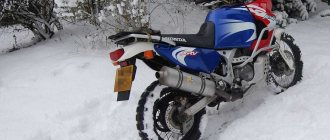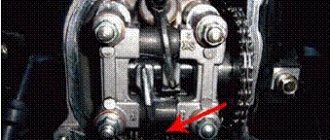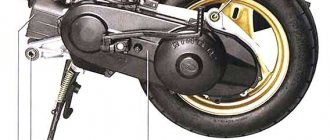Low temperatures and heavy rainfall are not conducive to riding a scooter or moped. It is extremely important to provide your two-wheeled friend with a decent rest during the forced “hibernation”, so that when spring comes, he will delight you again.
In our latitudes, a moped is a seasonal vehicle. It is enough for the temperature to drop to almost zero, and mopeds and scooters will begin to disappear en masse from the roads. There is nothing strange about this. At low positive temperatures and driving at a speed of about 60 km/h, the driver feels the air temperature a couple of degrees below zero. In addition, heavy rainfall and large amounts of fallen leaves on roads pose a significant threat to people riding two-wheelers. In this situation, owners of scooters, motorcycles and mopeds should think about preparing their devices for long periods of downtime. To avoid unnecessary expenses in the spring and start a new motorcycle season with the arrival of the first sunny days, you need to remember several rules.
Oil
If the moped is parked in an unheated garage, where the air temperature can drop below zero, you need to think about changing the oil. Old waste fluid may contain water, which will likely cause damage to the suspension. There are at least two differing opinions on the issue of optimal timing for changing engine oil. The first is a replacement on the eve of the autumn-winter downtime, the second is in the spring, immediately before the start of the season. Both options have their pros and cons, but in any case, you should remember to install a new filter, especially since it will cost a very small amount.
Preparing your scooter for winter
Even in a heated garage there is moisture, be it melt water or condensation. It especially harms frames that are not very well painted, screws and nuts. If you have the opportunity to purchase oil in a can, then good; if not, then use regular oil and a cloth. Lubricate the metal parts of the frame, engine, front fork with a thin layer. OIL SHOULD NOT GET ON THE BRAKE DISC, drop a couple of drops into the ignition switch and luggage compartment.
The brake lever and rear brake adjustment mechanism must be cleaned. The nut on the rear brake drive rod should turn easily, the thread should be clean. If you ride in winter, lubricate the moving parts and components of your scooter. This prevents the penetration of water and salt. The throttle and brake cables should also be lubricated. To do this, tighten the cable tensioning mechanisms on the gas handle (brake lever) until you have access to the cable; drop a little oil on the cable and move it back and forth, repeat this several times. After lubrication is complete, adjust the tension of the cables and remove excess oil. Pay attention to whether the brake cable running under the engine is securely fastened.
If you are not going to drive in winter, then fill up a full tank of gasoline. This will prevent rust from appearing on its inner surface. It also wouldn’t hurt to add 50 ml of oil for two-stroke engines to the gasoline. The oil forms a thin film on the inner surface of the cylinder and piston in the carburetor, which will prevent rusting. This oil will not harm the engine. After this, start the engine and let it run for 10 minutes.
Standard tires are not designed for winter driving. Already on a wet road, the scooter slips; at low temperatures, the rubber hardens, so for winter trips, use winter or all-season tires. It is also recommended to lower the tire pressure by about 0.2 - 0.3 and place the scooter only on the middle stand, this relieves the load on the wheels. It is recommended to place a couple of planks under it, it will be even better for the wheels.
The battery requires special attention. Add distilled water to it (if necessary). NEVER ADD ACID!, lubricate the contacts with Vaseline. For the winter, remove the battery and bring it home. Charge the scooter battery using chargers designed for this purpose. The charging current is usually from 4 to 6 A. Try not to exceed these values. Before charging, open the battery cap (if equipped). Charging must be done at a temperature not lower than 10 degrees. The battery should be recharged once every two months.
Please note that motorcycle plastics become brittle at low temperatures. Even minor shocks and vibrations from the motor can damage the plastic lining.
Rubber is sensitive to frost. During wintering, wheel tires may crack (even if the wheels are not loaded) and, very importantly, the variator belt. Therefore, it is necessary to wash the wheels and treat them with a special compound that protects the rubber. It is advisable to reduce the tire pressure by half in order to reduce internal stress in the tires; this measure will extend the life of the rubber. The same applies to the variator belt.
In winter, the front shock absorber feathers often suffer from moisture and condensation. And as a result - hopelessly damaged shock absorbers after 100 km of run in the next season, since rust on the feathers eats up the shock absorber bushings or oil seals (if the shock absorber is hydraulic). To prevent this, it is necessary to clean the shock absorber feathers from dirt, and then treat the surface of the feather with a thin layer of grease.
When driving in winter, salt corrodes aluminum wheel rims. Therefore, after each trip it is necessary to wash them, wipe them dry and treat them with a special compound.
As an alternative to adding oil to gasoline, it is recommended to unscrew the spark plug and drop a couple of drops of oil into the cylinder, then use the kick starter leg to crank the engine several times.
Very often, when the scooter is parked in winter, the surface of the driven pulley cheeks becomes covered with rust. If you do not take measures to prevent corrosion of the working surface of the driven pulley, then after putting it into operation next season, the belt will wear out very quickly or completely fail. To protect the working surface of the driven pulley, you can use the same grease applied in a thin layer (only then it will be necessary to remove it so that the belt does not slip).
It would be a good idea to service all the cables in winter, and especially the speedometer cable. It is he who primarily suffers from condensation. It is not difficult to serve. You just need to remove it, remove the cable from the sheath, lubricate it with oil and reassemble everything in the reverse order. With the brake and gas cables, things are somewhat more complicated, since they are non-separable, so you will have to be smart to spill lubricant between the cable itself and its sheath, but I advise you to do this procedure, since the service life of the cable in this case will be significantly extended.
If the room in which the scooter is stored is very humid, then there is a possibility that the crankshaft journals in the places where it mates with the oil seals may also rust. This is fraught with damage to the working edges of the oil seal due to corrosion products of the crankshaft journal and failure of the oil seal. Therefore, the crankshaft journals in the area of their interface with the oil seal should be treated with an aerosol penetrating lubricant. If the scooter owner does not have sufficient skills to dismantle the variator clutch and generator rotor (to provide access to the crankshaft seals), then it is better for him to contact a specialist.
Tires
Before putting a moped or scooter in the garage for long-term storage, you need to check the tire pressure and, if necessary, inflate them to the manufacturer’s recommended value. However, to avoid tire deformation, the device must be positioned so that the wheels do not touch the ground. To do this, you can use special racks or at least wooden blocks. Before heading out on the road for the first time in the new season, check the tire pressure again. It is advisable to do this on unheated tires.
Winter clothes.
Having completed the necessary procedures with the scooter, you should pay attention to the driver’s equipment. Suitable clothing for ATVs or snowbikes. In terms of comfort, equipment with a heater would be ideal. To protect your hands, it is not enough to use ordinary gloves, but it is better to use plastic covers. They are installed on the steering wheel to protect from wind and wetness.
A helmet is very important when driving; it protects the driver’s head in case of an accidental fall. However, ordinary helmets fog up and a person is not protected from the cold. A special heated helmet helps. It heats the frame and face shield.
How to ride? Here are the tips:
- Do not turn the throttle sharply, this will lead to skidding and falling.
- Sharp braking causes the scooter to skid off the road.
- Tilt or sudden turn of the steering wheel will cause you to fall.
- Maintaining the speed limit will help avoid sudden maneuvers.
Battery
If you want the engine to start without any problems in the spring, you will have to remove the battery. While at 25 degrees below zero a fully charged battery has 100% capacity, at 10 degrees below zero its power drops by 30%. Therefore, it is necessary to store the battery in a dry and well-ventilated area where the temperature does not drop below 5 degrees. Manufacturers recommend charging the battery once every 30 days at a charging current of 1/10 of the battery capacity. If using an 8 amp hour battery, you should set the charger to 0.8 amp and charge the battery for 10 hours. Although these days, automatic chargers designed for two-wheelers are widely available in the market, which themselves determine when and with what current to charge the battery.
How to ride a scooter in winter
If you managed to start the moped engine in winter, congratulations - you can study this article further. If not, look at our publication about how to start a scooter in winter here.
So, you started the scooter engine and the question immediately arises: is it necessary to warm up the engine in winter ? The answer is clear - yes! The scooter engine must be warmed up even in summer, and in winter the warm-up time must be approximately doubled so that the oil becomes less viscous and the parts get used.
Riding a scooter in winter poses many dangers:
- Do not turn the throttle sharply, because you will immediately be carried away into a skid, and this is fraught with injuries to both the driver and the scooter.
- You can't brake suddenly. The grip on the road surface is very poor even with winter tires. And in general, try to slow down with the engine.
- Do not tilt the scooter or turn the handlebars sharply - there is a high risk of falling.
- Don't speed. Depending on the road conditions and the brand of scooter, I recommend reaching a maximum speed of no more than 30 - 50 km/h.
Riding a moped in winter should be extremely careful. One ill-considered sudden movement and you could end up under a scooter. Read more about riding a scooter in bad weather conditions here.
I hope we answered most of the questions about how to ride a scooter in winter . Read us further - it will be interesting!
Scooter equipment in winter
As we said above, not only the scooter needs insulation, but also you yourself, because it is more important for you not to freeze. In any case, winter equipment differs from the usual one, because it is not only warmer, but also involves slightly different things. A scooter, like other unprotected vehicles, has the same equipment, so the equipment from an ATV or a simple motorcycle will suit you. It must include gloves, which should not only be warm, but also have a grip on the handle. If you want to be fully equipped and have extra funds, you can buy winter gear with heated options. Of course, such things cost a lot, but you will be very comfortable. The equipment also includes a motorcycle helmet, which, by the way, can also be purchased with heating. For ideal warmth, you can equip the scooter itself with heating - the handlebars and the seat. But this is for the most demanding.
Storing a scooter in a warm garage or outside in winter
When storing a moped for the winter in a warm, non-humid room, it is not necessary to carry out all of the above points for preparing and preserving the scooter for the winter. For example, you don’t have to remove the battery , but just disconnect the negative terminal from the scooter and recharge it once a month. We also recommend starting the engine 3-4 times during the winter period and letting it run for 10-20 minutes.
If you do not have the opportunity to leave your horse either in a warm room or in a cold garage, and you are going to store your scooter outside in the winter, then cover it tightly with a tarpaulin cover. Tarpaulin does not allow moisture to pass through, but air does. You should not cover the moped with a film or material that does not allow steam to pass through - condensation will form from the inside and will result in rusting of the metal parts. Of course, everything stated above regarding the proper preparation of the battery, engine and scooter in general for winter when storing the moped in this way must be carried out with double responsibility. But you must understand that it is still not recommended to store a moped in winter in this way.
Following these simple rules for preserving and preparing your scooter for winter will help you enjoy riding a moped during the first warm weather in the spring, rather than having to deal with scooter repairs. Good luck!
Preserving the engine for the winter
A separate point worth highlighting is the question of how to preserve the engine for the winter . I don’t think it’s worth explaining why in a separate paragraph: the engine is the most important component of a scooter.
As you have already noticed in this publication, we provide information on the ideal preservation of a scooter for the winter. Such preparation of a moped for winter requires physical, material, and some moral costs (however, as with any maintenance, repair or tuning of a moped). But the result will not be long in coming in the spring :).
Preserving the engine for the winter begins by treating the crankshaft journals with a special aerosol lubricant. This will prevent the engine shaft from seizing due to rust on the journals.
If there is carbon deposits on the piston and valves, then you should disassemble the CPG and clean these elements. Also, when preparing the engine for winter, it is recommended to add a fuel system cleaner to the fuel, as well as purchase and apply a carbon remover and drive approximately 50 km. Removing carbon deposits should be taken seriously, as its parts can lead to mechanical damage to the cylinder-piston group.
To properly preserve the engine, it is recommended to replace the engine oil with new one. Under no circumstances should the engine crankcase be left empty (corrosion is a risk).
To protect the internal surfaces of the CPG from corrosion, special aerosols must be used. For 4t engines, this aerosol is launched through the spark plug hole, and then the crankshaft is cranked with a kick starter or starter for 5-10 s. For 2t scooters, the spray is first sprayed directly into the carburetor of a running engine for 15-20 s. Then the engine is turned off and the product is launched through the spark plug hole in the same way as with four-stroke engines. Instead of an aerosol, you can pour 3-5 cubic meters into the candle hole with a syringe. see engine oil and crank the starter a couple of times. This way we will lubricate the walls of the cylinder and piston.
How to prepare a moped?
The first thing you need to do is thoroughly wash your vehicle. And coat all moving parts with lubricant. Then you need to insulate the engine by making a homemade cover. By blocking the free access of cold air (for forced air cooling engines). Candles are replaced with special ones - hot ones. They have a lower heat rating, and oil does not collect on the electrodes, forming carbon deposits. Fuel quality also plays a role in engine performance in winter. Refueling with low-quality fuel will lead to excessive consumption, and the water contained in the fuel may freeze and block the flow of fuel.
Slippery road surfaces are the reason why people stop riding two-wheelers in winter. Summer (piste) tires with weak grip are not suitable for winter skiing. It is possible to find special winter tires, however, this is rare. Instead, you can wear special snow chains. Or reduce the pressure by 0.3-0.5 atmospheres. This will increase the tire's contact patch with the road.











